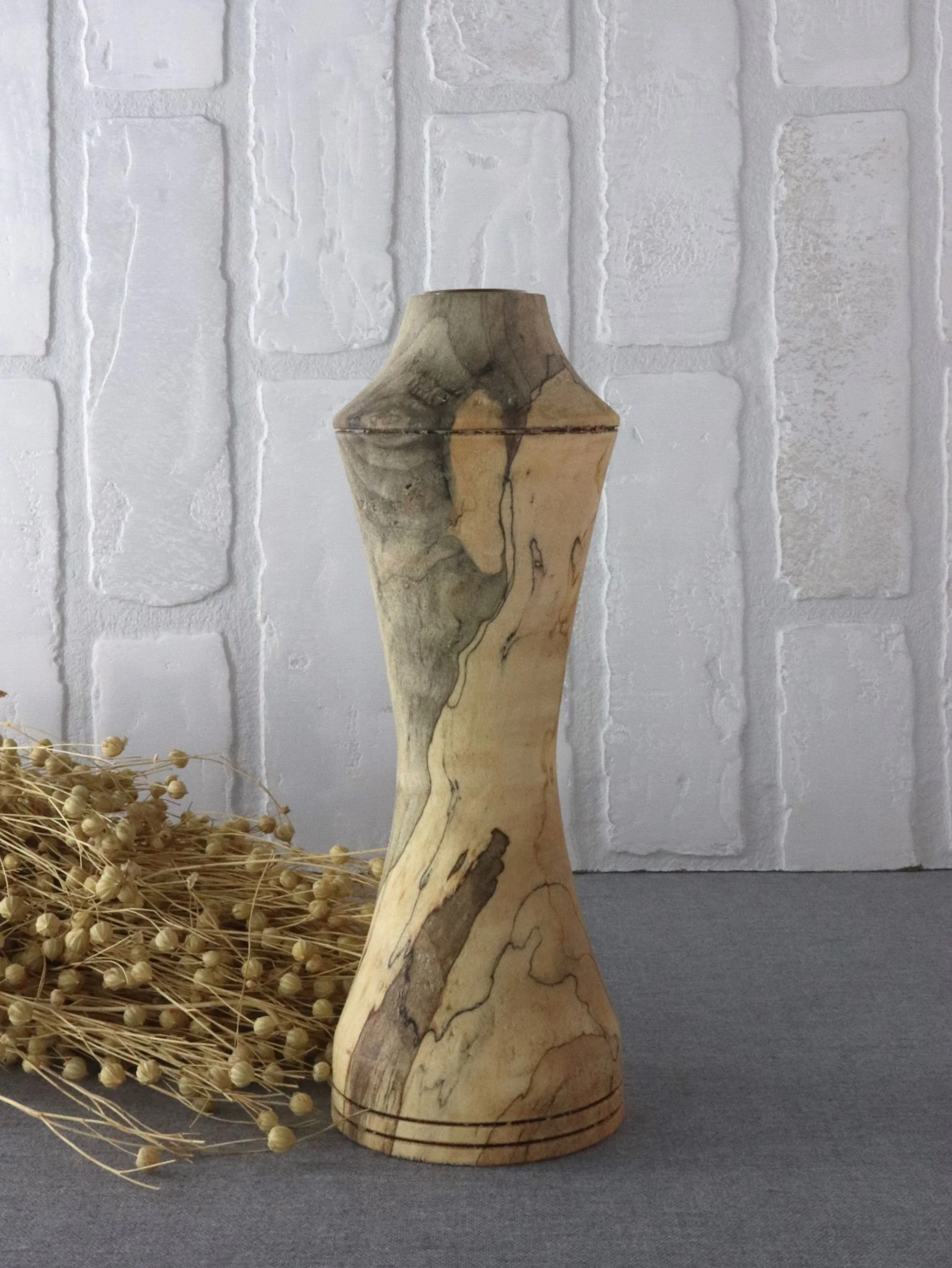Ambrosia Maple: When Beetles and Trees Create Art Together
As an artisan woodworker who specializes in reclaimed materials, I've learned that the most beautiful pieces often come with the most interesting stories. Ambrosia maple is no exception. Its unique character tells a tale of collaboration between nature's smallest architects and one of our most beloved hardwoods.
What is Ambrosia Maple?
Here's where many people get confused: ambrosia maple isn't actually a species of tree. It's regular maple – typically sugar maple, red maple, or silver maple – that has been transformed by tiny insects called ambrosia beetles. These beetles, no larger than a grain of rice, bore intricate tunnel systems through the wood, creating the distinctive gray and black streaking that makes ambrosia maple so prized among woodworkers and collectors.
Ambrosia Maple Bowl by Grayhill Woodworking LLC
The term "ambrosia" reflects the beetles' intriguing partnership with the wood they inhabit. Rather than simply consuming the wood like most boring insects, ambrosia beetles create fungal farms inside their tunnel networks. The beetles cultivate this fungus as their primary food source, and as it grows throughout their tunnel systems, it produces the distinctive gray and black patterns that make ambrosia maple so sought after.
The Science Behind the Beauty
Understanding what causes ambrosia maple helps us appreciate its unique characteristics. When ambrosia beetles attack a maple tree, they introduce fungal spores as they tunnel through the wood. These fungi don't harm the structural integrity of the wood – in fact, the maple often continues to grow and thrive. Instead, the fungi create mineral-like staining that follows the beetles' pathways, resulting in those signature gray streaks.
This transformation happens naturally in living trees, which is why the wood maintains its structural integrity. This is crucial to understand because it means the wood maintains its strength and workability while gaining incredible visual interest. As someone who has turned dozens of maple bowls on my lathe, I can attest that ambrosia maple works just like any other maple – it's simply more beautiful.
Ambrosia Maple vs. Spalted Maple: Understanding the Difference
Spalted Maple Bowl by Grayhill Woodworking LLC
Having written previously about spalted maple, I'm often asked about the difference between these two decorative woods. While both feature distinctive patterns created by fungi, they're actually quite different in appearance and formation.
Spalted maple develops its characteristic black zone lines when different fungal species compete for territory within the wood. These fungi typically attack dead or dying wood, creating bold, dark lines that look like ink drawings. The process can compromise the wood's structural integrity if allowed to progress too far.
Ambrosia maple, on the other hand, features the gray and black streaking caused by ambrosia beetles and their fungal partners. The patterns are typically more flowing and organic, following the beetles' tunnel systems. Since this occurs in living trees, the wood remains structurally sound.
Think of spalted maple as nature's abstract art – bold, dramatic, and geometric. Ambrosia maple is more like a watercolor painting – subtle, flowing, and organic. Both are beautiful, but they serve different aesthetic purposes in woodworking projects.
Here's something fascinating that many people don't realize: a single piece of maple can exhibit both ambrosia and spalted characteristics. When a tree experiences beetle attack during its lifetime and later develops spalting after death or injury, you get an extraordinary combination of flowing gray streaks from the beetles alongside the bold zone lines from competing fungi. These dual-character pieces are exceptionally rare and prized by collectors, offering the best of both natural decorative processes in one stunning board.
How to Identify Ambrosia Maple
Spalted Ambrosia Maple Vase by Grayhill Woodworking LLC
Recognizing ambrosia maple becomes easier once you know what to look for. The key identifying characteristics include:
Gray streaking patterns: The most obvious feature is the distinctive gray to black streaking that flows with the wood grain. While spalted maple displays bold, angular zone lines, ambrosia maple features graceful, curved patterns that follow the beetles' pathways.
Pin holes: You'll often see small, round holes where the beetles entered the wood. You'll notice these small entry points are usually about 1-2mm across and often found in groups.
Staining depth: The discoloration in ambrosia maple typically penetrates deeper into the wood than surface stains, making it visible even after significant material removal during turning or milling.
Wood integrity: The wood remains structurally sound, even with extensive beetle activity, making it reliable for functional pieces. The wood should feel solid and sound, not soft or punky.
Working with Ambrosia Maple: A Craftsman's Perspective
From a woodworker's standpoint, ambrosia maple is a dream to work with. It machines beautifully, turns smoothly on the lathe, and takes finishes exceptionally well. The key to showcasing its beauty lies in understanding how to complement the natural gray streaking rather than fighting against it.
When I design pieces using ambrosia maple, I study each board carefully to understand how the beetle patterns flow through the wood. For the three live edge bowls currently in my collection, I oriented each piece to highlight the natural streaking, allowing the gray lines to follow the bowl's curves and create visual movement.
The wood's workability is identical to regular maple – it's dense, fine-grained, and stable. This makes it perfect for functional pieces like bowls, cutting boards, and furniture components. The added visual interest comes at no cost to durability or performance.
The Perfect Choice for Unique Home Décor
Ambrosia Maple Bowl by Grayhill Woodworking LLC
For interior designers and home décor enthusiasts, ambrosia maple offers something truly special: guaranteed uniqueness. No two pieces are alike because no two beetle infestations follow the same pattern. This means that whether you're selecting a handcrafted bowl for your dining table or a custom piece for a client's home, you're guaranteed a one-of-a-kind work of art.
The subtle gray streaking complements both modern and traditional interiors, adding natural character without overwhelming other design elements. It's sophisticated enough for formal settings yet warm enough for casual spaces.
Nature's Collaboration in Every Piece
Ambrosia maple represents one of nature's most beautiful collaborations – the partnership between beetles, fungi, and trees that creates something far more interesting than any of them could achieve alone. As woodworkers, we're privileged to be part of this story, transforming these naturally decorated boards into functional art that will be treasured for generations.
The three ambrosia maple bowls in my current collection each tell their own story through their unique gray streaking patterns. Like all my work, they're crafted from reclaimed materials, honoring the trees that grew them. Each piece is a testament to the hidden beauty that surrounds us – we just need to know how to look for it.
Gray Hill Woodworking LLC specializes in handcrafted, functional art created from locally reclaimed wood. Each piece is unique and one-of-a-kind, celebrating the natural beauty and character found in rescued materials throughout New Jersey, Pennsylvania, New York, and Maryland.




